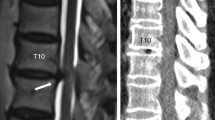Abstract
Purpose
Symptomatic thoracic disc herniation (TDH) is relatively rare, but patients with progressive myelopathy require surgical treatment without delay in diagnosis. The aim of this study was to review clinical and radiological features in patients with TDH presenting with myelopathy.
Methods
A total of 28 consecutive patients with thoracic myelopathy (Frankel grade C or worse) due to TDH who underwent surgery were divided into 3 groups based on the time for development of myelopathy (acute (< 72 h), subacute (within a few weeks), and chronic [gradually over > 1 month)] and their data were analyzed.
Results
The patients in the acute group were significantly younger and had a higher body mass index (BMI) compared to those in the subacute and chronic groups. Most cases of acute myelopathy were affected in the upper thoracic level, whereas all patients with subacute and chronic myelopathy had lesions in the lower thoracic level below T8–9. Interestingly, the affected thoracic level in patients with acute myelopathy matched the upper line of the sternum. The rate of acquired walking ability without assistance was only 50.0% in the acute group.
Conclusions
This study suggests that TDH presenting with acute myelopathy may have different clinical and radiological features compared to those of TDH with subacute and chronic myelopathy. Upper TDH should be suspected in cases of acute myelopathy that develops with sudden-onset back pain after certain triggers in younger and higher BMI people. These affected thoracic level matched with the upper line of the sternum in each case.





Similar content being viewed by others
References
Arce CA, Dohrmann GJ (1985) Herniated thoracic disks. Neurol Clin 3:383–392
Yoshihara H (2014) Surgical treatment for thoracic disc herniation: an update. Spine (Phila Pa 1976) 39:E406–E412. https://doi.org/10.1097/BRS.0000000000000171
Wood KB, Blair JM, Aepple DM, Schendel MJ, Garvey TA, Gundry CR, Heithoff KB (1997) The natural history of asymptomatic thoracic disc herniations. Spine (Phila Pa 1976) 22:525–529
Yamasaki R, Okuda S, Maeno T, Haku T, Iwasaki M, Oda T (2013) Surgical outcomes of posterior thoracic interbody fusion for thoracic disc herniations. Eur Spine J 22:2496–2503. https://doi.org/10.1007/s00586-013-2877-3
Frankel HL, Hancock DO, Hyslop G, Melzak J, Michaelis LS, Ungar GH, Vernon JD, Walsh JJ (1969) The value of postural reduction in the initial management of closed injuries of the spine with paraplegia and tetraplegia. I Paraplegia 7:179–192
Nakajima H, Takahashi A, Kitade I, Watanabe S, Honjoh K, Matsumine A (2019) Prognostic factors and optimal management for patients with cervical spinal cord injury without major bone injury. J Orthop Sci 24:230–236. https://doi.org/10.1016/j.jos.2018.10.001
Hamilton MG, Thomas HG (1990) Intradural herniation of a thoracic disc presenting as flaccid paraplegia: case report. Neurosurgery 27:482–484
Ueyama T, Tamaki N, Kondoh T, Miyamoto H, Akiyama H, Nagashima T (1999) Non-traumatic acute paraplegia associated with cervical disc herniation: a case report. Surg Neurol 52:204–206
Cornips EM, Janssen ML, Beuls EA (2011) Thoracic disc herniation and acute myelopathy: clinical presentation, neuroimaging findings, surgical considerations, and outcome. J Neurosurg Spine 14:520–528. https://doi.org/10.3171/2010.12.SPINE10273
Brauge D, Madkouri R, Reina V, Bennis S, Baussart B, Mireau E, Aldea S, Gaillard S (2017) Is there a place for the posterior approach in cases of acute myelopathy on thoracic disc hernia? World Neurosurg 107:744–749. https://doi.org/10.1016/j.wneu.2017.08.100
Watkins R 4th, Watkins R 3rd, Williams L, Ahlbrand S, Garcia R, Karamanian A, Sharp L, Vo C, Hedman T (2005) Stability provided by the sternum and rib cage in the thoracic spine. Spine (Phila Pa 1976) 30:1283–1286
Oda I, Abumi K, Cunningham BW, Kaneda K, McAfee PC (2002) An in vitro human cadaveric study investigating the biomechanical properties of the thoracic spine. Spine (Phila Pa 1976) 27:E64–70
Liebsch C, Graf N, Appelt K, Wilke HJ (2017) The rib cage stabilizes the human thoracic spine: an in vitro study using stepwise reduction of rib cage structures. PLoS ONE 12:e0178733. https://doi.org/10.1371/journal.pone.0178733
Okada E, Daimon K, Fujiwara H, Nishiwaki Y, Nojiri K, Watanabe M, Katoh H, Ishihama H, Fujita N, Tsuji T, Nakamura M, Matsumoto M, Watanabe K (2019) Ten-year longitudinal follow-up MRI study of age-related changes in thoracic intervertebral discs in asymptomatic subjects. Spine (Phila Pa 1976) 44:E1317–1324. https://doi.org/10.1097/BRS.0000000000003145
Panjabi MM, Takata K, Goel V, Federico D, Oxland T, Duranceau J, Krag M (1991) Thoracic human vertebrae. Quantitative three-dimensional anatomy. Spine (Phila Pa 1976) 16:888–901
Karadimas SK, Gatzounis G, Fehlings MG (2015) Pathobiology of cervical spondyloticmyelopathy. Eur Spine J 24(Suppl 2):132–138. https://doi.org/10.1007/s00586-014-3264-4
Ellingson BM, Woodworth DC, Leu K, Salamon N, Holly LT (2019) Spinal cord perfusion MR imaging implicates both ischemia and hypoxia in the pathogenesis of cervical spondylosis. World Neurosurg 128:e773–e781. https://doi.org/10.1016/j.wneu
Funding
No funding was received for this study.
Author information
Authors and Affiliations
Corresponding author
Ethics declarations
Conflict of interest
The authors report no conflict of interest concerning the materials or methods used in this study or the findings specified in this paper.
Ethical approval
The study protocol was approved by the Human Ethics Review Committee of our University Medical Faculty and strictly followed the Clinical Research Guidelines of the Ministry of Health, Labor, and Welfare of the Japanese Government.
Additional information
Publisher's Note
Springer Nature remains neutral with regard to jurisdictional claims in published maps and institutional affiliations.
Rights and permissions
About this article
Cite this article
Nakajima, H., Watanabe, S., Honjoh, K. et al. Differences in clinical and radiological features of thoracic disc herniation presenting with acute progressive myelopathy. Eur Spine J 30, 829–836 (2021). https://doi.org/10.1007/s00586-020-06485-6
Received:
Revised:
Accepted:
Published:
Issue Date:
DOI: https://doi.org/10.1007/s00586-020-06485-6




